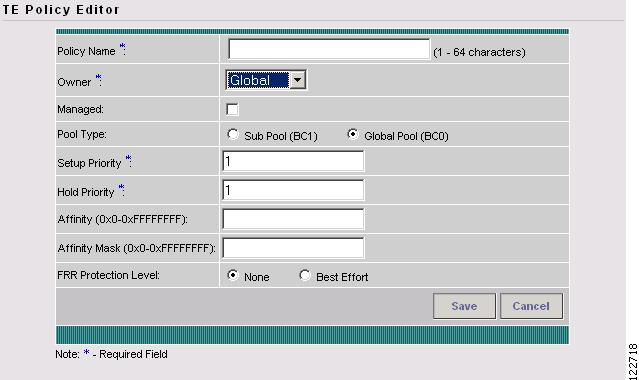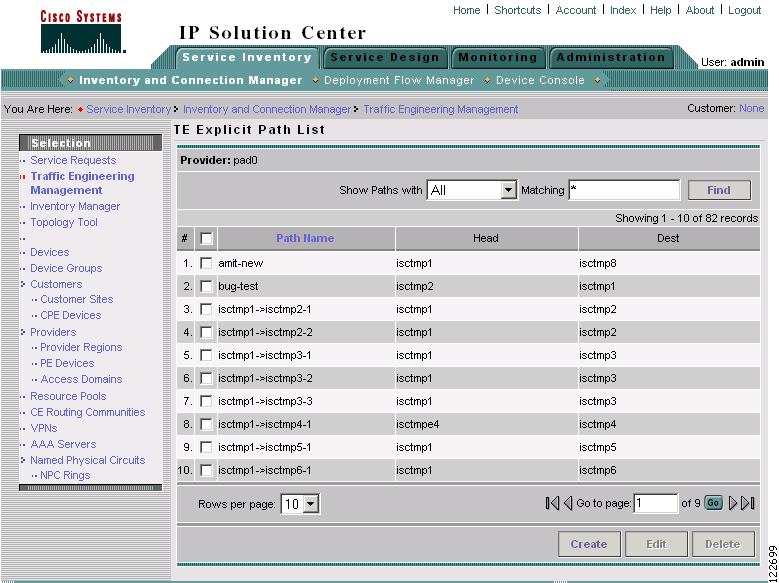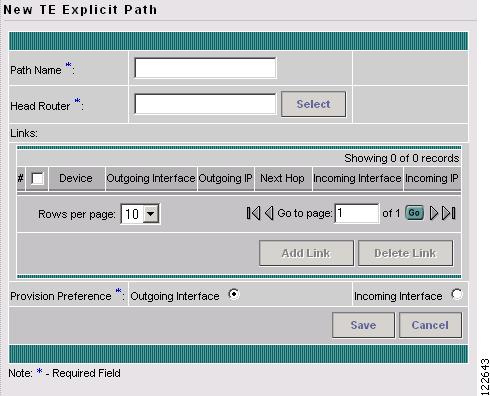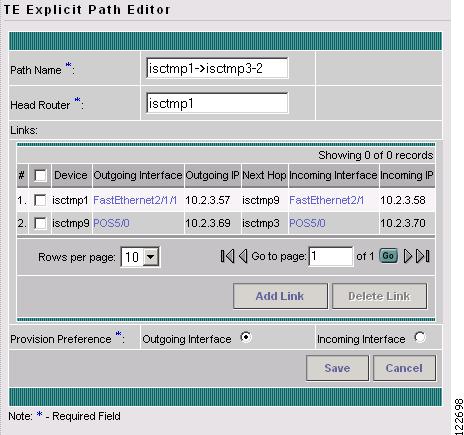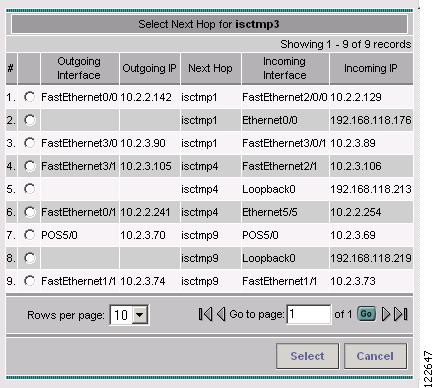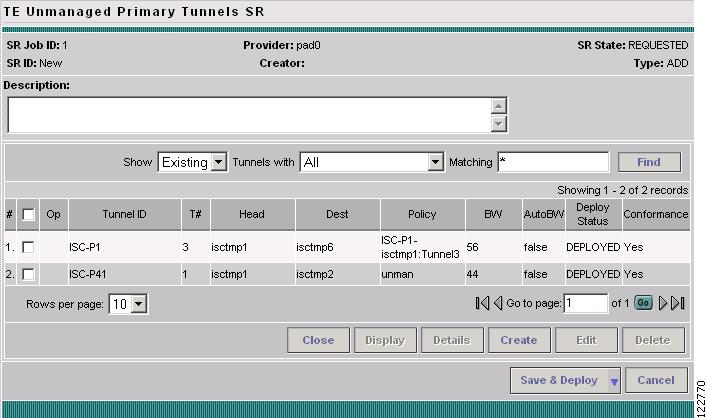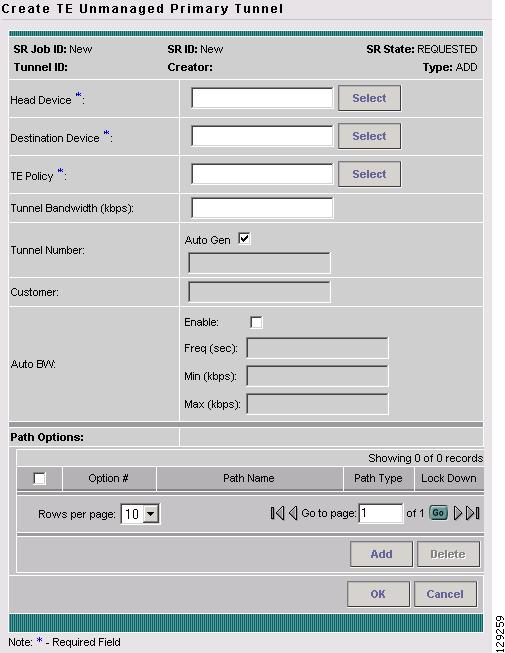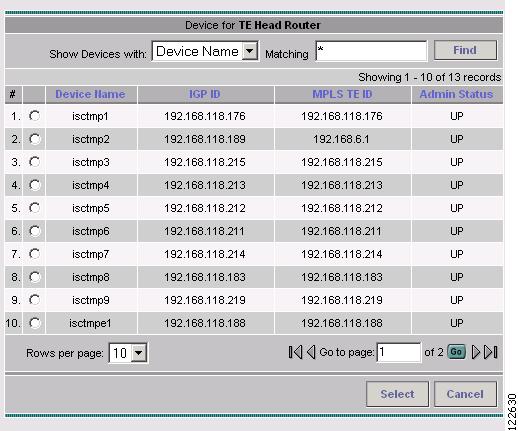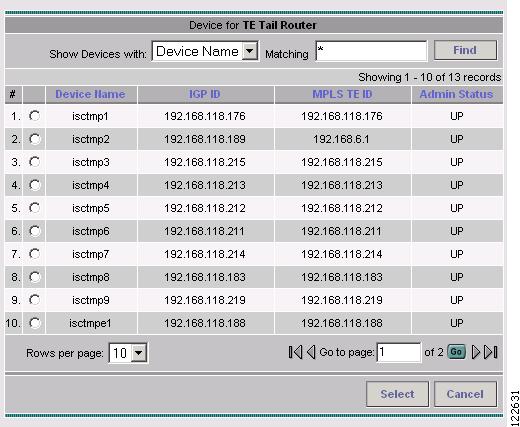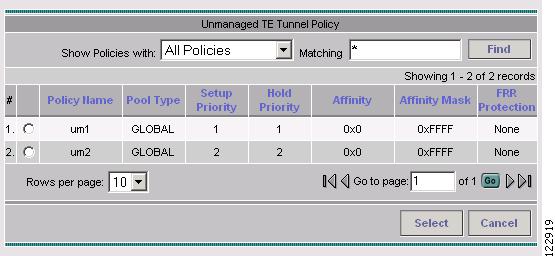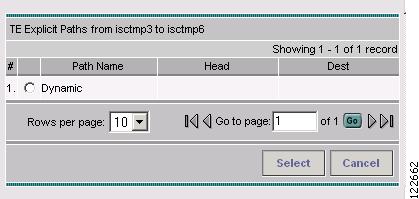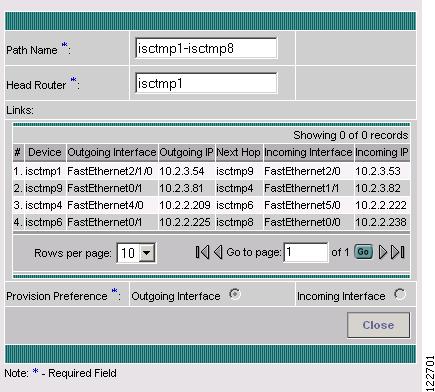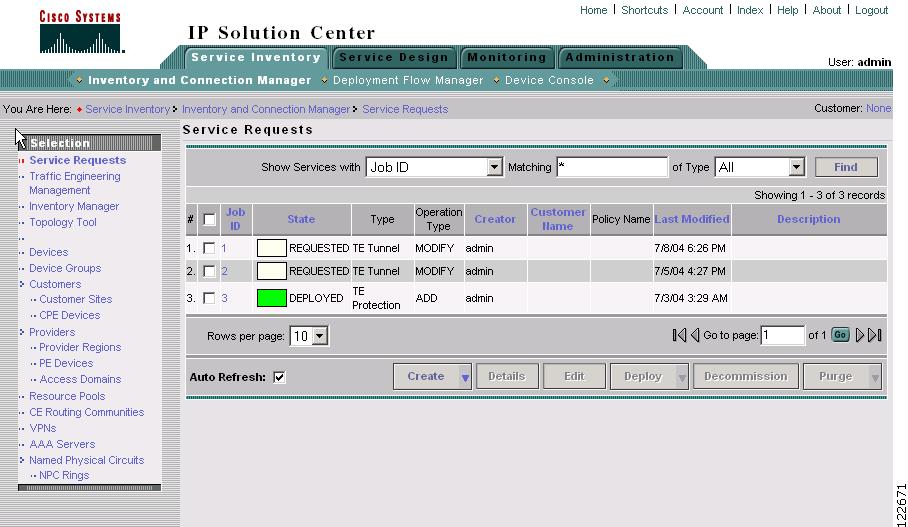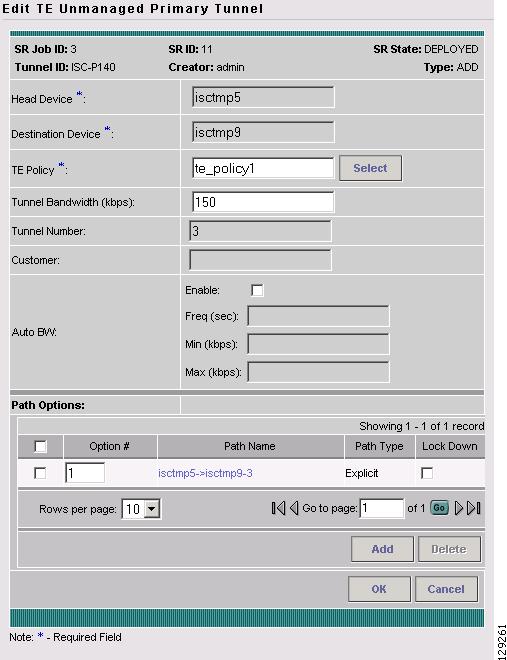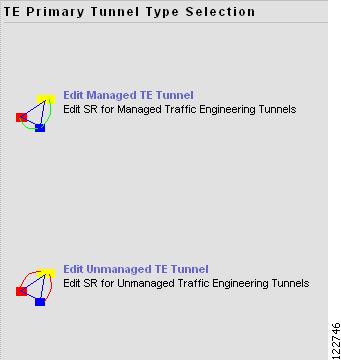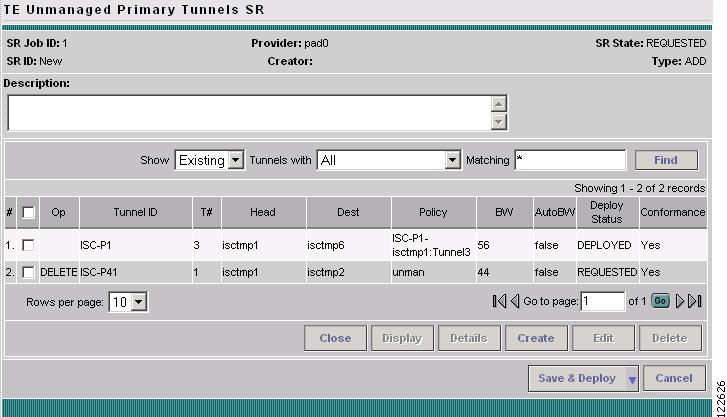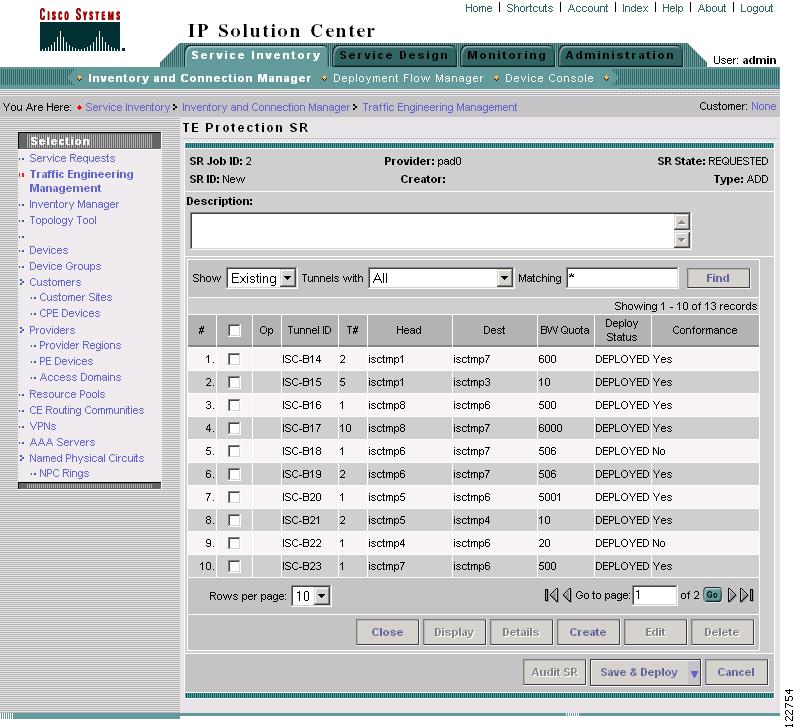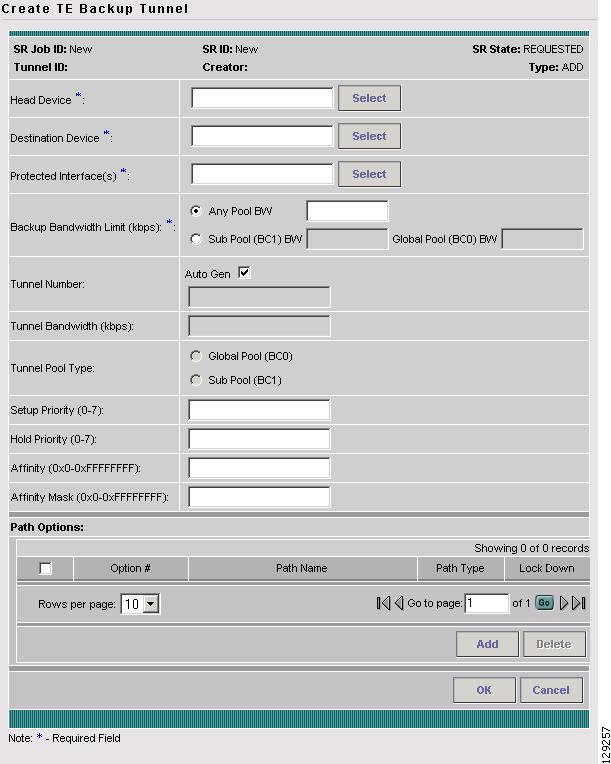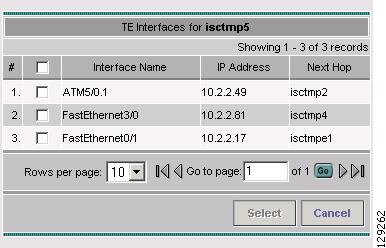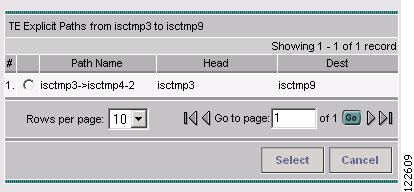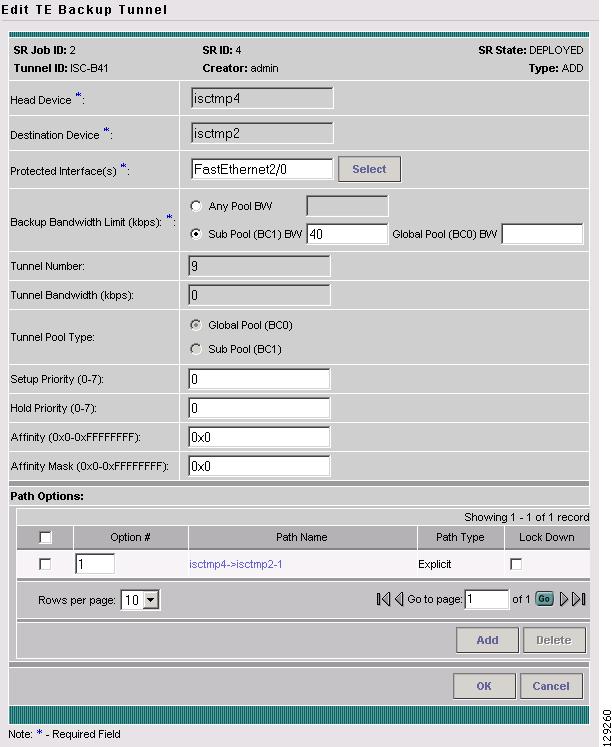

-
Cisco IP Solution Center Traffic Engineering Management User Guide, 4.0
-
Index
-
About This Guide
-
Introduction to ISC TEM
-
Setting Up the Service
-
TE Network Discovery
-
TE Resource Management
-
Basic Tunnel Management
-
Advanced Primary Tunnel Management
-
Protection Planning
-
Traffic Admission
-
Administration
-
Task Monitoring
-
TE Topology
-
Traffic Engineering Management GUI
-
Warnings and Violations
-
Document Type Definition (DTD) File
-
Table Of Contents
Access from Primary Tunnel SR Window
Access from Service Requests Window
From the Service Requests Window
Basic Tunnel Management
This chapter describes the processes involved in creating primary and backup tunnels with ISC TEM. To create a tunnel, certain steps must first be performed as described in previous chapters.
Primary tunnels are characterized by carrying traffic during normal operation. They have a prioritized list of possible paths, by which traffic can be routed. At any one time, the highest priority path available will be used to route traffic. If this fails, traffic will normally be re-routed via the next available path until a higher priority path becomes available again.
Prior to setting up the tunnel, a TE policy governing the traffic must be defined. An explicit path is created to establish the route and, in the case of a primary tunnel, it is created as either a managed or an unmanaged tunnel.
The purpose of a backup tunnel is to carry FRR protected traffic around a failed element until the routing in the network has reconverged. It is intended to protect traffic travelling along primary tunnels. There can be many backup tunnels protecting the same traffic through the use of load balancing.
If the network fails to reconverge, the backup tunnel will remain in place.
The difference between managed and unmanaged tunnels is described in Managed/Unmanaged Primary Tunnels.
The concept of bandwidth pools from which tunnels reserve bandwidth is important to understand. This is described in Bandwidth Pools.
This chapter contains the following sections:
Create TE Policy
To create a primary tunnel, each primary tunnel must be associated with a policy. A policy can be used by multiple tunnels.
For backup tunnels, this step is not necessary. In this case, proceed to Create Explicit Path.
For other TE policy management operations, see TE Policies, page 9-2.
The TE policy is a set of rules governing the TE network and defines the Class-of-Service (for example, gold, silver, bronze) for primary tunnel traffic.
ISC TEM has a notion of Managed and Unmanaged policies. Managed policies have setup/hold priorities of 0/0 and can have additional pathing constraints such as protection level and max delay. Tunnels with Unmanaged policies are provisioned by the system, but the system only tracks the deployment, not the operation of the tunnel. Unmanaged policies cannot have a setup/hold priority of zero.
Policies are managed under Policy Manager in Service Design. For a more detailed explanation of the Policy Manager GUI, see TE Policies, page 9-2.
To create a TE policy, use the following steps:
Step 1
Navigate to Service Design > Policy Manager.
Step 2
Click the Policy Manager icon.
The Policies window in Figure 5-1 appears.
Figure 5-1 Policies Window
Step 3
Click Create and select TE Policy to set up a new TE policy.
To edit an existing policy, select the policy that you want to modify and click Edit. The TE Policy Editor window in Figure 5-2 appears.
Note
A policy that is being used by a tunnel cannot be modified. You can use Edit to view the path.
Figure 5-2 TE Policy Editor
For an explanation of the various window elements, see TE Policies, page 9-2.
Step 4
Fill in the required fields marked with an asterisk (*) and any optional fields.
If you intend to use the TE policy for managed tunnels, make sure to check the Managed check box. When setting up a policy for a managed tunnel, the Setup and Hold priorities are automatically set to zero (highest priority). In the case of a policy for an unmanaged tunnel, you can specify the desired Setup and Hold priority settings.
Step 5
Click Save.
Create Explicit Path
This section describes how to create a TE explicit path. For other TE explicit path operations, see TE Explicit Paths.
Paths are defined between source and destination routers, possibly with one or more hops in between. Paths are used for primary and backup tunnels in the explicit path option(s).
If you intend to create an explicit path for managed tunnels, the path should not contain any non-TE interfaces. Paths with non-TE interfaces will be filtered out by the tunnel path chooser of the tunnel editor for managed tunnels and backup tunnels (not unmanaged tunnels).
To create or edit an explicit path, use the following steps:
Step 1
Navigate to Service Inventory > Inventory and Connection Manager > Traffic Engineering Management.
Step 2
Click TE Explicit Paths. The TE Explicit Path List window appears. (see Figure 5-3)
Figure 5-3 TE Explicit Path List
For an explanation of the various window elements, see Create/Edit Explicit Path.
Step 3
To create an explicit path in the TE Explicit Path List, click Create. The New TE Explicit Path window in Figure 5-4 appears.
To edit an explicit path in the explicit path list, select the explicit path that you want to modify and click Edit. The TE Explicit Path Editor window in Figure 5-5 appears.
Note
An explicit path that is being used by a tunnel cannot be modified. However, use Edit to view the path.
Figure 5-4 New TE Explicit Path
Figure 5-5 TE Explicit Path Editor
For an explanation of the various window elements, see Create/Edit Explicit Path and Edit TE SR (Primary or Backup).
Note
If a path is used by any tunnel, no modifications are possible. The Outgoing Interface and Incoming Interface links are not selectable and the Provision Preference line as well as the Add Link, Delete Link, and Save buttons disappear.
Step 4
Specify a pathname and select a head router.
Step 5
Click Add Link. A blank line is added to the hop list table.
Step 6
Now an outgoing or an incoming interface must be selected for the head router. Under Outgoing Interface, click Add Link. The Select Next Hop window in Figure 5-6 appears.
Figure 5-6 Select Next Hop
The next hop list contains all the possible next hops of the router (pop1-dus, for example), excluding the ones already included in the explicit paths (to avoid path loops).
The next hop list contains TE interfaces and one non-TE interface for each router. For TE interfaces, the Outgoing Interface and Outgoing IP columns are populated by the application.
Note
If a non-TE interface is selected, Provision Preference (Figure 5-4) is set to Incoming Interface. The provision preference cannot be set manually.
Step 7
Select an interface and click Select. The corresponding link information is added to the new explicit path in the Links table as shown in Figure 5-7.
The incoming interface field is automatically populated.
Figure 5-7 New Link for TE Explicit Path
Step 8
To add another link, click Add Link again.
Step 9
To modify an existing link, click the link in the Outgoing Interface or the Incoming Interface columns, make the desired changes, and click Select.
Step 10
Optionally, select Provision Preference by clicking either the Outgoing Interface or the Incoming Interface radio button.
Note
If you try to select the Provision Preference before adding a link when non-TE interfaces are present, the Add Link process overrides the Provision Preference and sets it to incoming.
Step 11
Click Save to keep the created TE explicit path or click Cancel to quit without saving.
Primary Tunnel Operations
ISC TEM allows you to perform a number of primary tunnel operations, which are described in the following.
Create Primary Tunnel
After a TE Policy and an explicit path have been set up, a primary tunnel can be created. There are two types of primary tunnels:
•
Managed Primary Tunnels
•
Unmanaged Primary Tunnels
Below, the GUI flow is described for creating unmanaged primary tunnels. It is very similar for managed primary tunnels and the few differences that exist are described in Managed/Unmanaged Primary Tunnels and Create Unmanaged TE Tunnel.
To create a managed or an unmanaged primary tunnel, use the following steps:
Step 1
Navigate to Service Inventory > Inventory and Connection Manager > Traffic Engineering Management.
Step 2
Click Create Managed TE Tunnel. The TE Managed Primary Tunnels SR window appears .
or
Click Create Unmanaged TE Tunnel. The TE Unmanaged Primary Tunnels SR window in Figure 5-8 appears.
In this example, we will create an unmanaged tunnel.
Figure 5-8 TE Unmanaged Primary Tunnels SR
For an explanation of the various window elements, see Create Managed TE Tunnel (same for managed and unmanaged).
Step 3
Click Create. The Create TE Unmanaged Primary Tunnel window in Figure 5-9 appears.
Figure 5-9 Create TE Unmanaged Primary Tunnel
For an explanation of the various window elements, see Create Managed TE Tunnel and Create Unmanaged TE Tunnel.
Step 4
To select a Head Device in the Create TE Unmanaged Primary Tunnel window, click the corresponding Select button to open the Select Device for TE Head Router window shown in Figure 5-10.
Figure 5-10 Select Device for TE Head Router
For an explanation of the various window elements, see Create Managed TE Tunnel and Create Unmanaged TE Tunnel.
Step 5
Select a head device and click Select. The Select Device for TE Head Router window closes and the prompt returns to the Create TE Unmanaged Primary Tunnel window.
Step 6
To select a Destination Device in the Create TE Unmanaged Primary Tunnel window, click the corresponding Select button to open the Select Device for TE Tail Router window shown in Figure 5-11.
Figure 5-11 Select Device for TE Tail Router
For an explanation of the various window elements, see Create Managed TE Tunnel and Create Unmanaged TE Tunnel.
Step 7
Select a destination device and click Select. The Select Device for TE Tail Router window closes and the prompt returns to the Create TE Unmanaged Primary Tunnel window.
Step 8
To select a Tunnel Policy in the Create TE Unmanaged Primary Tunnel window, click the corresponding Select button to open the Select Unmanaged TE Tunnel Policy window shown in Figure 5-12.
Note
To create a managed tunnel, make sure that one or more managed tunnel policies are available. If that is not the case, go to Policy Manager (see Create TE Policy) and make sure to check the Managed check box.
Figure 5-12 Select Unmanaged TE Tunnel Policy
For an explanation of the various window elements, see Create Managed TE Tunnel and Create Unmanaged TE Tunnel.
Step 9
Select a policy and click the Select button. This brings you back to the tunnel editor.
Step 10
Click Add to set up path options for the tunnel. The Select TE Explicit Path window in Figure 5-13 appears.
The Path Options section provides two path types, Explicit Path and Dynamic Path.
An Explicit Path is a fixed path from a specific head to a specific destination device.
A Dynamic Path is provisioned by allowing the head router to find a path. The dynamic keyword is provisioned to the routers.
Figure 5-13 Select TE Explicit Path
For unmanaged tunnels, paths can be either explicit or dynamic.
Step 11
Select the desired TE Explicit Path unless you prefer dynamic path only. If none is available, you can set one up first. To do so, see Create Explicit Path.
Click Select.
The selected path appears in the Path Options section of the create window as shown in Figure 5-14.
Figure 5-14 Path Options
For explicit paths (<head_device>-><destination_device>), you can click the pathname to open the non-editable Explicit Path Viewer as shown in Figure 5-15.
Figure 5-15 TE Explicit Path Viewer
For an explanation of the various window elements, see Create/Edit Explicit Path.
Step 12
In the Create TE Unmanaged Tunnel window, click OK to accept the entered tunnel information or click Cancel to quit and return to the TE Unmanaged Primary Tunnels SR window.
Step 13
In the TE Unmanaged Primary Tunnel SR window, the Op field changes to ADD.
Note
The added tunnel can be reverted to its original state by selecting it and clicking Delete. The ADD flag in the Op column disappears.
Step 14
In the TE Unmanaged Primary Tunnel window, click Save & Deploy (see Note) to either deploy the new tunnel SR to the network or force deploy all tunnels, or you can create or edit more primary tunnels and then save and deploy all changes.
For a further description of save and deploy options, see Create Managed TE Tunnel.
Note
For managed tunnels, there is a Proceed with Changes >> button that is used to continue with Save & Deploy (see Chapter 6, "Advanced Primary Tunnel Management").
Note
With the exception of TE Traffic Admission SRs, TE SRs are always deployed immediately from the specific TE SR window, not from the Service Requests page in Inventory and Connection Manager.
Step 15
The Service Requests window (Service Inventory > Inventory and Connection Manager > Service Requests) appears (see Figure 5-16) and displays the state of the deployed SR.
Figure 5-16 Service Requests - Unmanaged Tunnels
If the SR does not go to the Deployed state, go to the Task Logs window to see the deployment log (Monitoring > Task Manager > Logs) as described in SR Deployment Logs, page 10-1.
To edit the service request from the Service Requests window, go back to the TE Managed Primary Tunnels SR or the TE Unmanaged Primary Tunnels SR window as described in Edit Primary Tunnel.
Edit Primary Tunnel
Primary tunnel attributes can be modified in the primary tunnel editor
There are two ways to access the primary tunnel editor:
•
from the managed or unmanaged primary tunnels SR window or
•
from the Service Requests window.
Access from Primary Tunnel SR Window
To access the primary tunnel editor from the primary tunnel SR window (TE Managed Primary Tunnels SR or TE Unmanaged Primary Tunnels SR window) and edit a managed or an unmanaged primary tunnel, use the following steps:
Step 1
Navigate to Service Inventory > Inventory and Connection Manager > Traffic Engineering Management.
Step 2
Click Create Managed TE Tunnel. The TE Managed Primary Tunnels SR window appears .
or
Click Create Unmanaged TE Tunnel. The TE Unmanaged Primary Tunnels SR window in Figure 5-8 appears.
Step 3
To edit a tunnel SR, select the desired SR and click Edit. The Edit TE Managed Primary Tunnel or the Edit TE Unmanaged Primary Tunnel window in Figure 5-17 appears.
Figure 5-17 Edit TE Unmanaged Primary Tunnel
The primary tunnel editor is identical to that of the create primary tunnel GUI. For an explanation of the various window elements, see Create Managed TE Tunnel and Create Unmanaged TE Tunnel.
Step 4
Make the desired changes and click OK or Cancel to discard the changes.
Step 5
In the TE Unmanaged Primary Tunnel SR window, the Op field changes to MODIFY.
Note
The modified tunnel can be reverted to its original state by selecting it and clicking Delete. The MODIFY flag in the Op column disappears.
Click Save & Deploy (see Note) to either deploy the new tunnel SR to the network or force deploy all tunnels, or you can create or edit more primary tunnels and then save and deploy all changes.
Step 6
The Service Requests window (Service Inventory > Inventory and Connection Manager > Service Requests) appears (see Figure 5-16) and displays the state of the deployed SR.
Access from Service Requests Window
To access the primary tunnel editor from the Service Requests window, assuming that the SR has been created, use the following steps:
Step 1
Navigate to Service Inventory > Inventory and Connection Manager > Service Requests.
Step 2
To edit the desired tunnel SR, select the SR in question and click Edit. The TE Primary Tunnel Type Selection window in Figure 5-18 appears.
Figure 5-18 TE Primary Tunnel Type Selection
Step 3
Specify the type of tunnel, managed or unmanaged. The TE Managed Primary Tunnel SR or the TE Unmanaged Primary Tunnel SR window appears displaying the SR selected in the Service Requests window. An example of the TE Unmanaged Primary Tunnel SR window is shown in Figure 5-8.
Step 4
Select the tunnel SR and click Edit. The Edit TE Unmanaged Primary Tunnel window in Figure 5-17 appears.
Go to Access from Primary Tunnel SR Window and continue the process from Step 4.
Delete Primary Tunnel
To delete a managed or an unmanaged primary tunnel from the primary tunnel SR window (TE Managed Primary Tunnels SR or TE Unmanaged Primary Tunnels SR window), use the following steps:
Step 1
Navigate to Service Inventory > Inventory and Connection Manager > Traffic Engineering Management.
Step 2
Click Create Managed TE Tunnel. The TE Managed Primary Tunnels SR window appears .
or
Click Create Unmanaged TE Tunnel. The TE Unmanaged Primary Tunnels SR window in Figure 5-8 appears.
Step 3
To delete a tunnel, select the desired tunnel(s) and click Delete. The Op field status changes to DELETE as shown in Figure 5-19.
Figure 5-19 TE Unmanaged Primary Tunnels SR - Delete Requested
For an explanation of the various window elements, see Create Managed TE Tunnel and Create Unmanaged TE Tunnel.
Note
The deleted tunnel can be reverted to its original state by selecting it and clicking Delete. The DELETE flag in the Op column disappears.
Click Save & Deploy to either deploy the new tunnel SR to the network or force deploy all tunnels, or you can create or edit more primary tunnels and then save and deploy all changes.
Step 4
The Service Requests window (Service Inventory > Inventory and Connection Manager > Service Requests) appears (see Figure 5-16) and displays the state of the deployed SR.
Backup Tunnel Operations
ISC TEM allows you to perform a number of backup tunnel operations, which are described in the following.
Create Backup Tunnel
Backup tunnels are created in much the same way as primary tunnels. In both cases, building an explicit path is not required when an existing path already traverses the desired routers. A path can be used for any number of tunnels within its bandwidth capacity.
A precondition for creating a backup tunnel is the presence of an explicit path. To create an explicit path, see Create Explicit Path.
To create a backup tunnel, use the following steps:
Step 1
Navigate to Service Inventory > Inventory and Connection Manager > Traffic Engineering Management.
Step 2
Click Create TE Backup Tunnel. The TE Protection SR window in Figure 5-20 appears.
Figure 5-20 TE Protection SR
For an explanation of the various window elements, see Create TE Backup Tunnel.
Step 3
Click Create. The Create TE Backup Tunnel window in Figure 5-21 appears.
Figure 5-21 Create TE Backup Tunnel
For an explanation of the various window elements, see Create TE Backup Tunnel.
Step 4
Select, at a minimum, a Head Device, a Destination Device, and a Protected Interface. Also, specify a Backup Bandwidth Limit greater than zero. Add other tunnel information as desired.
Figure 5-22 Select TE Protected Interface
For an explanation of the various window elements, see Select TE Protected Interface.
Step 5
Click Add to add just one path. The Select TE Explicit Path window in Figure 5-23 appears.
Figure 5-23 Select TE Explicit Path
Step 6
Select an explicit path. It must match the head and destination of an existing path. If none is available, you first must set one up. To do so, see Create Explicit Path.
Step 7
Click Select. The selected path appears in the Path Options section of the page as shown in the Select TE Explicit Path window in Figure 5-24.
Figure 5-24 Path Options
For explicit paths, you can click the pathname to open the Explicit Path Viewer as shown in Figure 5-15.
Step 8
In the Create TE Backup Tunnel window, click OK to accept the entered tunnel information or click Cancel to quit the window without saving it. The window closes.
Step 9
In the TE Protection SR window, the Op field changes to ADD.
Note
The added tunnel can be reverted to its original state by selecting it and clicking Delete. The ADD flag in the Op column disappears.
Step 10
Click Save & Deploy to either deploy the new tunnel SR to the network or force deploy all tunnels, or you can create or edit more backup tunnels and then save and deploy all changes.
Figure 5-25 Save & Deploy Tunnels
The Save & Deploy button provides two options:
–
SR Tunnels Only—Deploy all tunnel changes that does not impact tunnel placement, or if no changes were made to the SR, use this to re-deploy the SR that was in Requested or Invalid state.
–
Force Deploy All Tunnels—Force deployment of all tunnels in this SR. This could be useful when previous provisioning of the SR has failed, so that it is necessary to force through the deployment of all tunnels in the SR.
Note
With the exception of TE Traffic Admission SRs, TE SRs are always deployed immediately from the specific TE SR window, not from the Service Requests page in Inventory and Connection Manager.
Step 11
The Service Requests window (Service Inventory > Inventory and Connection Manager > Service Requests) appears and displays the state of the deployed SR.
If the SR does not go to the Deployed state, go to the Task Logs window to see the deployment log (Monitoring > Task Manager > Logs) as described in SR Deployment Logs, page 10-1.
Edit Backup Tunnel
Backup tunnel attributes can be modified in the backup tunnel editor
There are two ways to access the backup tunnel editor:
•
from the Protection SR window or
•
from the Service Requests window.
From the Protection SR Window
To access the Protection SR window to edit a backup tunnel, use the following steps:
Step 1
Navigate to Service Inventory > Inventory and Connection Manager > Traffic Engineering Management > Create TE Backup Tunnel. The TE Protection SR window appears.
Step 2
To edit a tunnel SR, select the desired SR and click Edit. The Edit TE Backup Tunnel window in Figure 5-26 appears.
Figure 5-26 Edit TE Backup Tunnel
The backup tunnel editor is identical to that of the create backup tunnel GUI. For an explanation of the various window elements, see Create TE Backup Tunnel.
Step 3
Make the desired changes and click OK.
Step 4
In the TE Protection window, the Op field changes to MODIFY.
Note
The modified tunnel can be reverted to its original state by selecting it and clicking Delete. The MODIFY flag in the Op column disappears.
Step 5
In the TE Protection SR window, click Save & Deploy to either deploy the new tunnel SR to the network or force deploy all tunnels, or you can create or edit more backup tunnels and then save and deploy all changes.
The Save & Deploy button options are discussed in Create Managed TE Tunnel.
Step 6
The Service Requests window (Service Inventory > Inventory and Connection Manager > Service Requests) appears (see Figure 5-16) and displays the state of the deployed SR.
From the Service Requests Window
To edit a backup tunnel from the Service Requests window, assuming that the SR has been created use the following steps:
Step 1
Navigate to Service Inventory > Inventory and Connection Manager > Service Requests.
Step 2
To edit the desired tunnel SR, select the SR in question and click Edit. The TE Protection SR window appears displaying the SR selected in the Service Requests window. An example of the TE Protection SR window is shown in Figure 5-20.
Step 3
Select the tunnel SR and click Edit. The Edit TE Backup Tunnel window in Figure 5-26 appears.
Go to From the Protection SR Window and continue the process from Step 3.
Delete Backup Tunnel
To delete a backup tunnel from the TE Protection SR window, use the following steps:
Step 1
Navigate to Service Inventory > Inventory and Connection Manager > Traffic Engineering Management > Create TE Backup Tunnel.
The TE Protection SR window in Figure 5-20 appears.
Step 2
To delete a tunnel SR, select the desired SR and click Delete. The Op field status changes to DELETE as shown in Figure 5-27.
Figure 5-27 TE Protection SR - Delete Requested
For an explanation of the various window elements, see Create TE Backup Tunnel.
Note
The deleted tunnel can be reverted to its original state by selecting it and clicking Delete. The DELETE flag in the Op column disappears.
Click Save & Deploy to either deploy the new tunnel SR to the network or force deploy all tunnels, or you can create or edit more primary tunnels and then save and deploy all changes.
Step 3
The Service Requests window (Service Inventory > Inventory and Connection Manager > Service Requests) appears (see Figure 5-16) and displays the state of the deployed SR.

 Feedback
Feedback

